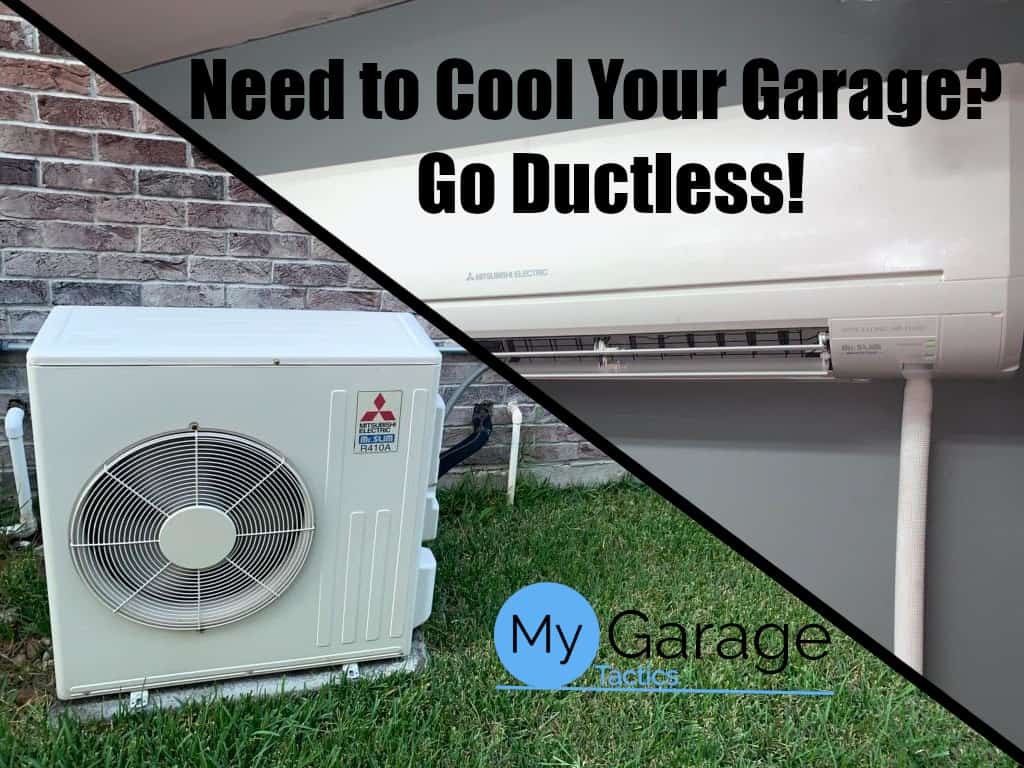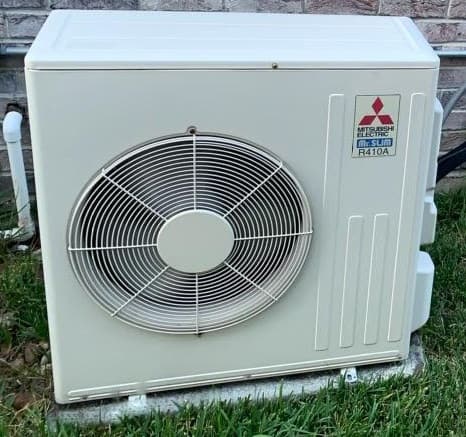
My garage is in Houston, Texas. That being said, to even consider using the garage as a functional living-space or workshop, cooling was my first priority. I wanted a sustained cooling solution rather than something I would have to manage as needed. After a considerable amount of research, it was evident that a Mitsubishi Electric Mr. Slim single-zone ductless mini split system would be best suited for my garage. It is the same system shown above in the featured picture and I could not be happier with the results. The rest of this article describes the benefits, cons and why I think you should get a mini split system for your home garage or small business.
A Ductless mini split system is highly efficient, quiet and available in many configurations. This makes it the perfect garage cooling solution despite the higher initial cost.
Mini Split Efficiency.
Typically, ductless mini split systems offer some of the highest SEER ratings amongst HVAC systems. SEER is the standard measurement of efficiency for heating and cooling systems. It’s formula takes many variables into consideration (like seasonal weather…) however, that is beyond the scope of this article. Please be advised, higher SEER ratings mean more efficient heating & cooling thus will pay for itself overtime in energy savings.
Mini Split Configurations.
One of my favorite things about mini split systems is how flexible they are. By that, I mean mini split systems offer single-zone or multi-zone setups with individual climate controls for each zone. Essentially ductless mini split systems consist of one or more indoor units connected to an single outdoor unit via power cables and insulated refrigerant tubing.

The indoor unit or units are known as the air handler or evaporator coil. There is many styles and colors for the indoor unit. Most are designed to hang on the wall but there are some available to be recessed in the ceiling. Each indoor unit can be controlled by a remote.
The blue arrow pointing to the insulated refrigerant tubing and power lines (aka, communication wire) which run down the wall and to the condenser outside. The orange arrow points to the condensation pipe which also runs outside to dispel in the grass.
Notice, all pipes, tubes and power lines can run inside the wall or behind the wall. In my case, I opted to have everything exposed.

The outdoor unit is the condenser and is usually attached to a concrete slab or attached to the side of the garage.
Increase the Value of Your Home with a Mini Split?
Compared to most other garage cooling solutions, ductless mini splits are permanent installations. Window AC units can retract from the value of the house. Most people like (or even love…) their cars. While I use the garage as an office, your mini split is guaranteed to catch the eyes of respectable home buyers. And in Texas, how can blame them! The idea of getting in a cool car every day sounds great!
Mini Split operating sounds, or lack thereof…
During operation the indoor air handler is almost silent which is perfect for working in the garage. Quiet operation is an important aspect for using my garage as a home office. The outside condenser unit is the only part of a mini split system that makes some noise and even that is minimal.
Garage Mini Split Cons.
By this point you are probably thinking this all sounds great, what’s the catch? In my honest opinion there is only one catch, unfortunately it’s a big one. Ductless mini split systems and installation come with a steep blow to the wallet. Almost all mini split systems cost a premium. Ductless mini split systems may need professional installation.
How Other Garage Cooling Solutions Stack Against the Mini Split.
In the time I spent researching the best way to cool the garage, there were three contenders competing for the top spot. Those are using a Portable AC, A Window AC Unit or the Ductless Mini Split. below you can see how they all stack up against each other.
| Solution | PROS | CONS |
|---|---|---|
| Ductless Mini Split | Very Efficient Quiet Operation Self-Managed Available DIY Systems | Cost Professional Installation (Unless DIY) |
| Portable AC | Minimal Installation Portable | Loud Operation Varied Costs |
| Window AC Unit | Minimal Installation | Loud Operation. Needs Window Maybe Restricted By HOA More Susceptible to Theft |
What Size Mini Split for a Garage?
There is really no precise answer to this question. The table below can give you a pretty good idea on how to calculate the BTU needed for your garage. It is always best to get a recommendation from a licensed HVAC technician. Many factors must be considered when determining the size of mini split that would be required to cool a garage. Size refers to how many BTU (British Thermal Unit) the particular ductless mini split system can produce.
The things you should really keep in mind are:
- Do the walls and ceilings have drywall?
- Is there insulation behind the walls and ceiling?
- Is the garage door insulated?
- Do you have adequate weather stripping around the garage door?
The table below has a range from Highly Insulated to Minimal Insulation. If you can answer yes to most of the questions above, then you should be okay with the Highly Insulated side of the range. If not, consider purchasing a higher BTU ductless mini split system.
| Average Garage Sizes | Square Footage | Highly Insulated | Minimal Insulation |
|---|---|---|---|
| One-car (12′ x 20′ ft.) | 240 ft² | 6,000 BTU | 9,000 BTU |
| Two-car (18′ x 20′ ft.) | 360 ft² | 9,000 BTU | 12,000 BTU |
| Three-car (22′ x 32′ ft.) | 704 ft² | 12,000 BTU | 18,000 BTU Plus |
What Will a Garage Mini Split Cost?
Ductless mini split pricing is the only topic I have not touched on yet, and for good reason. Prices depend heavily on the specific system and configuration needed. To calculate that you need the prior information I’ve gathered.
For a single-zone garage, expect to pay $950-$2,550 on a quality brand mini split and materials needed. You can save a few hundred on other brands, however, professional installation still costs upwards of $1,000 or more depending on location.
The price fluctuation varies by on the size and brand of the mini split system. You can forgo the professional installation if you purchase a DIY-friendly ductless mini split system and have the knowledge required. (Not every mini split is DIY friendly, only mini splits specifically made to be DIY should be attempted by a non-profession. You can read more about this in the frequently asked questions section of this article.)
Garage Mini Split Frequently Asked Questions
Before purchasing my home, I knew my goal was to convert the garage into my workshop / office. At the time, I was doing a lot of research on the subject of ductless mini splits and had a lot of questions arise. I am lucky to have a close friend whom is a professional HVAC technician. The questions below are questions I asked followed by a summary of her answer.
“My home already has an HVAC system, why should I use a ductless mini split in the garage?”
-Jordan
A lot of people already have a ducted HVAC system in their home and wonder if they can simply route existing ducting to the garage. In theory that sounds great! but here is the issue, the vast majority of the time, your garage is not nearly as air-tight or as well insulated (if insulated at all). Sound also travels in ducting to other rooms in the house which can be bothersome. Plus, existing systems and ducting were designed specifically for the size and layout of your home so branching off those systems disastrous or costly results (unless specifically recommended by your licensed HVAC technician)
“What’s the difference between a NON-DIY and a DIY-Friendly ductless Mini Split?”
-Jordan
The majority of mini splits are not DIY (Do it yourself) friendly because of the refrigerant tubing. The copper refrigerant tubing which spans between the inside blower and the outside condenser is pressurized to meet the specifications of the specific unit. Adding the refrigerant requires specialized tools and abiding by local laws because it is considered a toxic chemical.
On the other hand, if you are the type of person who likes to do it yourself and have a good understanding of electrical wiring, you’re in luck! DIY-friendly mini splits are available to order online. The key difference with DIY mini splits is the copper tubing comes pre-pressurized from the manufacturer. There are a few pitfalls with DIY mini splits, the first is the copper tubing comes with a predetermined length which can’t be cut or altered. Another pitfall is once the copper tubing is connected to either unit, it can not be disconnected.
